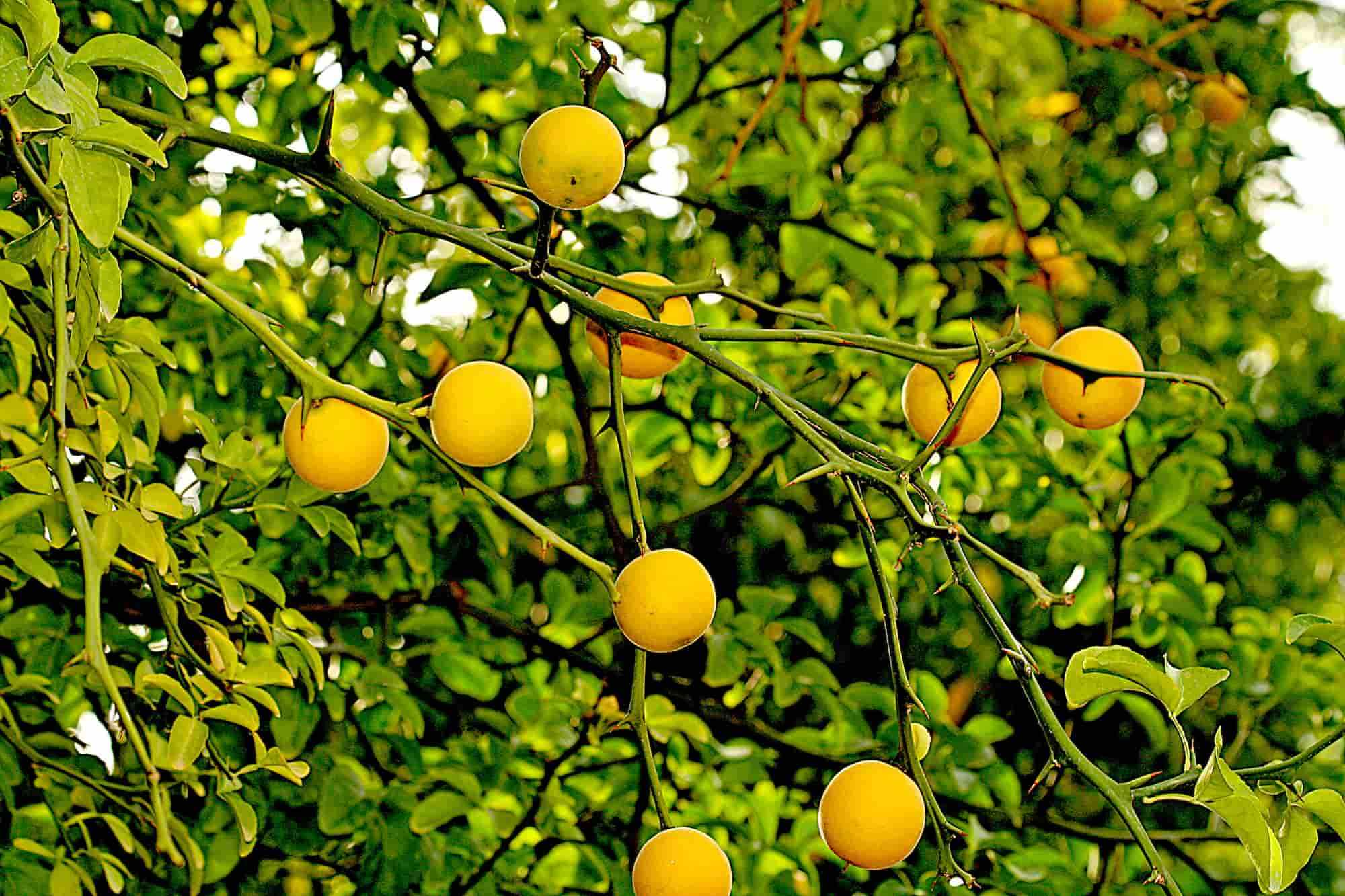
Poncirus: planting, caring for, and harvesting the fruits
Contents
Poncirus in a nutshell
- Poncirus trifoliata is a cold-resistant citrus
- It can be grown in the ground throughout France in full sun
- It offers a beautiful fragrant white flowering
- Its fruits, known as poncirs, can be eaten cooked
- Because its branches bear thorns, it can be used as a defensive hedge.
A word from our expert
The Poncirus trifoliata is the only citrus that can grow in the ground in all regions of the territory. This particularity is due to its great hardiness as it can withstand temperatures down to –20°C. However, it can also be grown in a pot and will spend the winter outdoors without any difficulty.
The main advantages of this deciduous bush lie in its delicate white spring flowering, fragrant and melliferous, on naked wood. This flowering is followed by the appearance of round fruits that grow during the summer. Initially green, the poncirus gradually turns yellow. The Poncirus trifoliata is also notable for its branches covered in thorns, making it suitable for use in a defensive hedge.
It requires a well-sunny location and, above all, protection from cold winds. It thrives in acidic or neutral soil, provided it is well-draining.
Botany and description
Botanical data
- Latin name Poncirus trifoliata
- Family Rutaceae
- Common name thorny orange, northern orange, trifoliate orange
- Flowering between March and May
- Height up to 4 metres
- Exposure full sun or light partial shade
- Soil type Well-drained, neutral to acidic
- Hardiness down to -20°C
The Poncirus trifoliata is a large bush from the Rutaceae family, which includes all citrus trees, particularly the Citrus genus that offers a complete range of edible fruits from oranges to grapefruits and lemons.
Native to Korea, Japan, and northern China, it is believed to have been introduced to Europe in 1850. The typical variety is the most widespread there. Less commonly, a few cultivars are found: Poncirus trifoliata ‘Flying Dragon’, also known as Hiryu, is recognised by its twisted branches that give it a remarkable habit. Less cold-tolerant than the typical species, this cultivar is used as a rootstock to produce dwarf citrus trees that are sturdier against winds. Poncirus trifoliata monstrosa is an American cultivar resulting from a mutation, not exceeding 2 metres and also featuring twisted and curled branches. These two cultivars are beginning to be introduced into gardens due to their unique branching, making them striking ornamental trees.
As for Poncirus trifoliata ‘Rubidoux’, it is primarily used as a rootstock for other citrus trees, due to its hardiness and disease resistance.
There is another, much rarer species, Poncirus polyandra, native to Korea and northern China, with deciduous to semi-evergreen foliage, producing orange fruits.
This bush with a rounded, bushy habit grows on a single trunk. It produces a deep taproot, allowing it to withstand drought well and be quite undemanding regarding its growing conditions. While in its native growing area it can reach 8 metres, in Europe, it rarely exceeds 4 metres in all directions. However, when grown in pots, it will have much more modest dimensions.
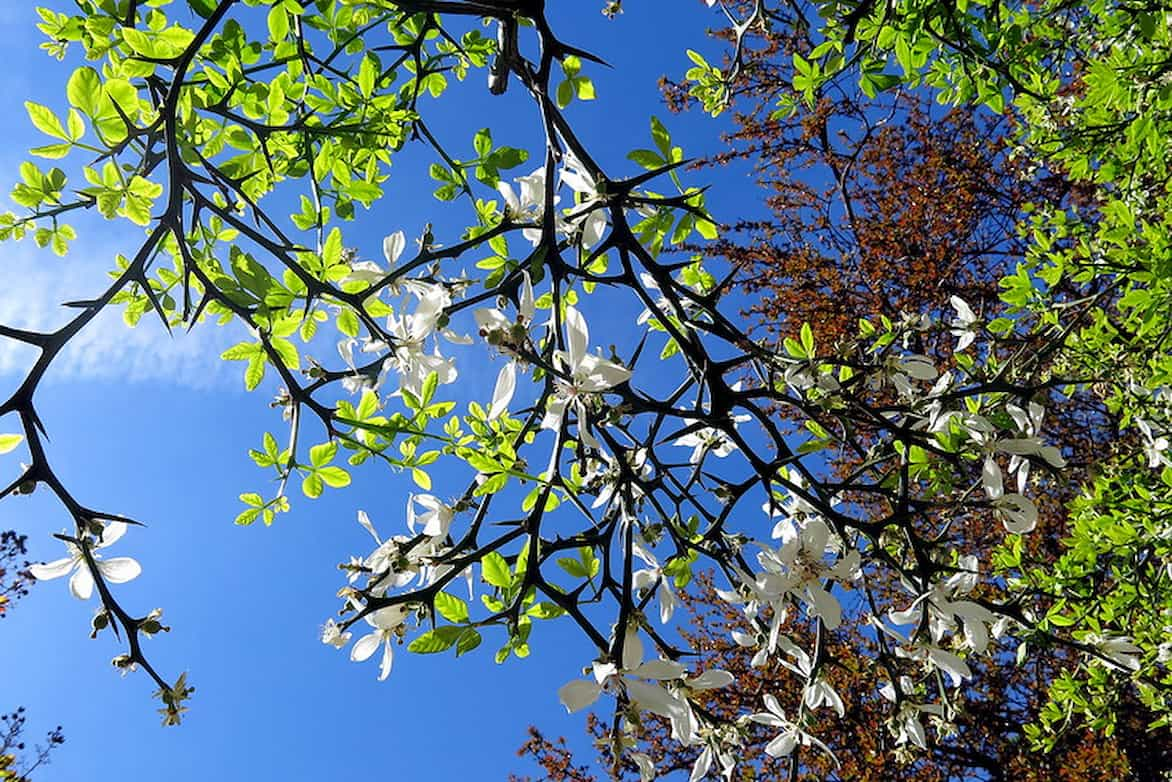
The Poncirus trifoliata is a cold-resistant citrus tree
This beautiful, particularly ornamental and decorative bush from the citrus family has the unique ability to grow in the ground, even north of the Loire. It can indeed withstand temperatures dropping to -15°C, or even -20°C if well sheltered from cold winds.
It finds its place in many gardens, especially since this thorny orange stands out with its beautiful white flowering, which emits a pleasant and sweet fragrance. Between March and May, depending on the climate, Poncirus trifoliata is covered in white cup-shaped flowers with 5 large petals and 20 stamens. In its native country, the Poncirus blooms from late winter to early spring. These flowers with practically translucent petals have the unique characteristic of blooming on bare wood. If the growing conditions are favourable, it is not uncommon for a second flowering to occur in early autumn.
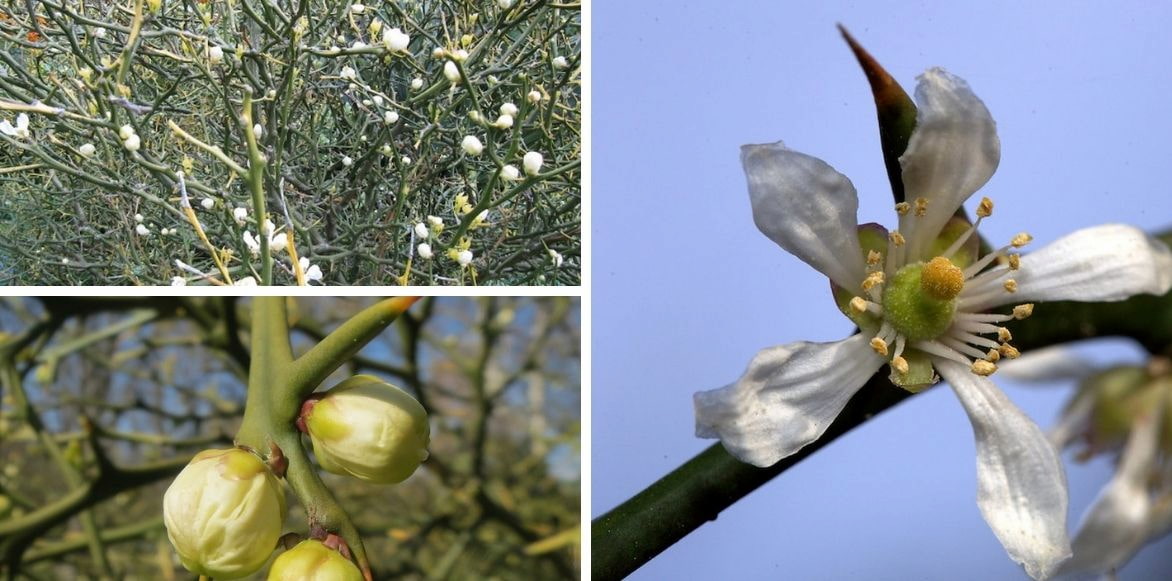
The white flowers with 5 petals of the Poncirus have the unique characteristic of blooming on bare wood
The Poncirus trifoliata has deciduous or semi-evergreen foliage in mild climates. The trifoliate, ovate leaves, measuring 3 to 4 cm in length, emerge light green before turning dark green and slightly glossy in summer. In autumn, they take on a golden hue. Like the flowers, the leaves are slightly aromatic.
The branches of the Poncirus trifoliata bear long, sharp, hooked dark green thorns that are decorative and striking in winter when the leaves have fallen. The presence of these thorns makes Poncirus an ideal bush for a defensive hedge. However, it is advisable to avoid planting it in areas frequently traversed by children or pets.
The flowering is followed by fruiting, which develops slowly in summer and reaches maturity in autumn. It is during this time that the Poncirus showcases its full beauty, as the golden leaves surround small orange fruits. The fruits, known as poncires, are covered in a velvety, downy skin, initially green then turning yellow to orange.
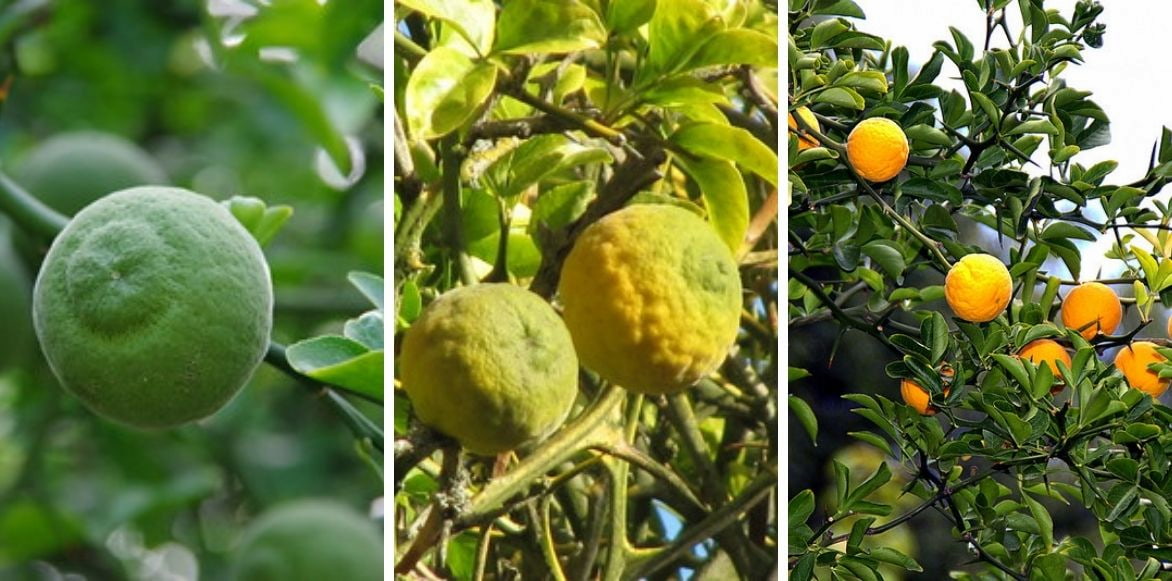
The different stages of maturity of the fruit that ripens throughout the summer
Measuring 3 to 5 cm in diameter, they are fragrant. They remain on the tree long after the leaves have fallen, creating a rather magical sight. The poncires contain numerous seeds. When raw, poncires are particularly acidic and bitter. Moreover, due to the presence of poncirine, they are inedible as they can cause intestinal issues. However, they can be consumed when cooked.
The main varieties
Still relatively underdeveloped in Europe, Poncirus trifoliata is the type variety. It is named for the shape of its leaves, which have three leaflets.
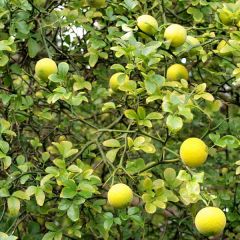
Poncirus trifoliata
- Période de floraison May, June
- Hauteur à maturité 4 m
There is another variety, Poncirus trifoliata ‘Flying Dragon’, which has a slower growth rate and is widely used in bonsai. This variety is distinctive for its twisted stems. The Poncirus trifoliata ‘Zig Zag’ shares the same characteristics as the type species but has much more contorted branches.
Planting
Where to plant?
As it is a citrus tree, Poncirus trifoliata requires sunlight. Therefore, provide it with a very sunny location, possibly in light shade in the southernmost regions, ideally sheltered from cold winds in areas with less mild winters. Indeed, icy winds can damage the flowers and compromise fruiting.
In terms of soil, Poncirus thrives in neutral to slightly acidic soil, but most importantly, well-drained. Waterlogged soil would be fatal for it in winter. However, it dislikes calcareous soils and appreciates soil enriched with organic matter.
In pots, Poncirus needs a very deep container filled with potting mix for citrus trees or Mediterranean plants, mixed with a bit of garden soil. Don’t forget to place a good layer of gravel or clay balls at the bottom of the container to facilitate drainage. Repotting every 3 to 4 years is recommended, interspersed with top dressing.
When to plant?
The best time to plant Poncirus is in spring, in March or April, or, if necessary, in September-October in areas with milder climates.
How to plant?
- Dig a hole 80 cm in all directions
- Enrich the soil with well-decomposed manure or compost
- Place the Poncirus trifoliata in the hole, ensuring not to bury the collar
- Backfill the hole and firm the soil around the base
- Water thoroughly.
- Mulch around the base to reduce watering
If you want to use Poncirus in a defensive hedge, space each plant 1 to 2 metres apart.
Entretien
The thorny lemon tree is an easy-going bush. In the year following planting, it requires regular watering, especially during the growing and fruiting periods in summer. After that, watering can be spaced out. Due to its deep root system, it withstands drought quite well.
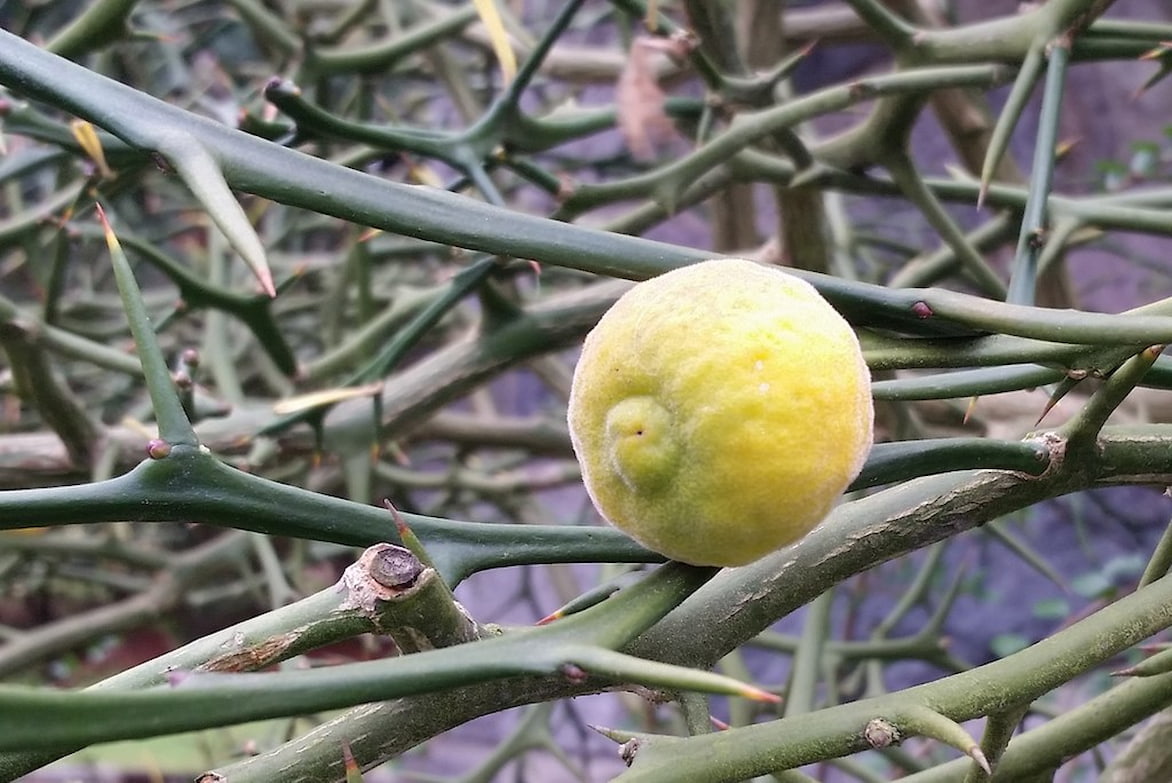
The thorny lemon must be watered in the year following planting. After that, it adapts and tolerates drought
If you are growing your Poncirus in a pot, watering should be regular. You can allow the substrate to dry out between waterings. A monthly application of fertiliser is recommended.
Pruning is not obligatory and can be particularly dangerous due to the presence of thorns. It simply allows for the removal of a few dead branches at the end of spring. It may also be necessary if you have planted the Poncirus in a hedge. In this case, make sure to wear thick gloves.
The Poncirus is very little affected by diseases and pests. This is one of the reasons it is used as a rootstock! Very rarely, it may be affected by anthracnose and sooty mould, due to the presence of aphids. Leaf miners or Mediterranean fruit flies may also attack it, but this remains anecdotal.
Multiplication
Multiplication by sowing is quite simple, but you can also propagate by cuttings.
Sowing
Sowing Poncirus is relatively straightforward and easy to succeed compared to other citrus trees. The seeds, fresh and just harvested from the fruits, are sown in spring in a mixture of potting soil and sand, just covered with a centimetre of soil. Before sowing, soak them overnight in warm water. Keep the trays at a temperature of 20 to 25 °C. The seeds germinate in 2 to 3 weeks. When the seedlings have three leaves, transplant them into pots that you can leave outside.
However, you must wait 7 to 8 years before it flowers and bears fruit.
Propagation by Cuttings
- In July or August, take the tip of a shoot measuring 15 to 20 cm
- Remove the leaves from the lower half of the shoot
- Plant in a mixture of cutting compost and sand
- Water lightly by spraying. The substrate should be moist but not waterlogged
- Keep your cuttings at 22 °C in a mini greenhouse, under a cloche or plastic film
Association
The Poncirus trifoliata stands out on its own in a lawn or at the centre of a flowerbed surrounded by a small boxwood hedge.
If you wish to use it in a defensive hedge, you can plant it alongside a white Japanese quince (Chaenomeles spéciosa), a Berberis thunbergii, a Prunus spinosa with its lovely white spring flowering, and a sea buckthorn.
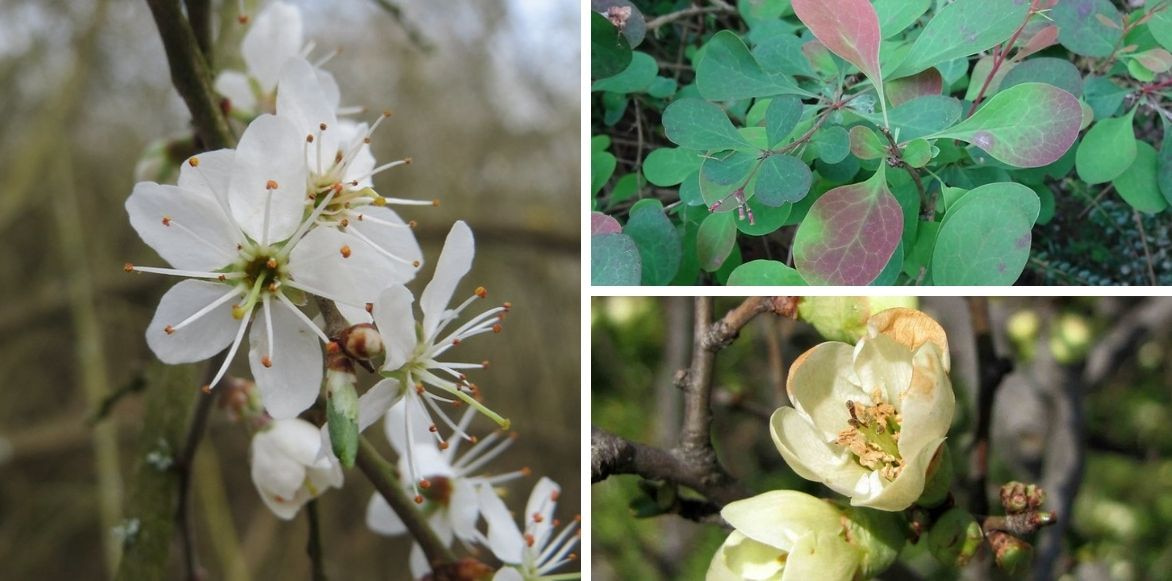
To create a defensive hedge, plant the Poncirus trifoliata alongside a Prunus spinosa, a berberis, and a Japanese quince (Chaenomeles speciosa)
Did you know?
The fruits of the thorny lemon tree resemble small green lemons at the beginning of fruiting. They are not edible raw as they are very unpleasant to taste. The skin is very thick and the pulp is extremely bitter. However, they can be consumed as marmalade or in very sweet jam, but one must be patient as a poncire can contain up to 50 seeds! They can also be made into wine.
In China, the poncire is used to flavour tea.
For further reading
Discover our entire collection of citrus trees.
Other citrus trees display a certain originality: finger lime, Buddha’s hand, and other combawas.
Everything you need to know about growing citrus trees: Lemon trees, orange trees, and other citrus trees: how to grow in pots and in the garden.
To learn all about overwintering citrus trees: Citrus trees: how to overwinter them and protect them from the cold in winter.
- Subscribe!
- Contents































Comments